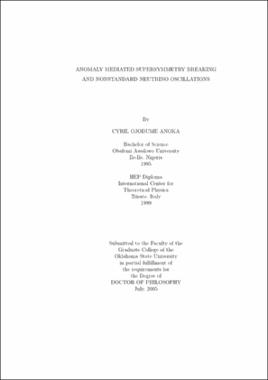| dc.contributor.advisor | Babu, Kaladi S. | |
| dc.contributor.author | Anoka, Cyril Ojodume | |
| dc.date.accessioned | 2013-11-26T08:26:28Z | |
| dc.date.available | 2013-11-26T08:26:28Z | |
| dc.date.issued | 2005-07 | |
| dc.identifier.uri | https://hdl.handle.net/11244/6873 | |
| dc.description.abstract | Scope and Method of Study: In this thesis, we propose four different scenarios that solves the tachyonic slepton mass problem of Anomaly Mediated Supersymmetry Breaking (AMSB). We also address the question of neutrino oscillation using non standard interactions. In the first two chapters we introduce the Standard Model (SM) of particle physics and Supersymmetry (SUSY). We review models of SUSY breaking in the third chapter. Chapters four, five, six and seven have our various models that address the negative slepton mass problem of AMSB. In chapter 8, we propose a simple solution to the neutrino oscillation problem based on nonstandard interactions. | |
| dc.description.abstract | Findings and Conclusions: AMSB is an attractive scenario which can neatly solve the flavor changing neutral current problem of SUSY models. However, the simplest such model has tachyonic sleptons, which is unacceptable. The first model we propose is based on a non-Abelian horizontal gauge symmetry broken at the TeV scale. In this model the sleptons receive positive mass-squared from the asymptotically free SU(3)H gauge sector. The second model is a class of supersymmetric Z 0 models based on the gauge symmetry U(1)x = xY--(B--L), where Y is the Standard Model hypercharge. For 1 < x < 2, the U(1)x D-term generates positive contribution to the slepton masses. The third model is the quark-lepton symmetric model based on leptonic SU(3)` gauge symmetry. The negative slepton mass problem is cured by virtue of the positive contribution to the slepton masses from the SU(3)` gauge sector. This model also leads to unification of Standard Model gauge couplings in a non trivial way. The fourth model is based on an asymptotically free SU(2)H gauge symmetry broken at the TeV scale. This model is viable and also solves the tachyonic slepton mass problem of AMSB. Finally in chapter 8, we show how the Liquid Scintillator Neutrino Detector (LSND) experiment puzzle may be solved by adding new physics terms to the standard interactions. | |
| dc.format | application/pdf | |
| dc.language | en_US | |
| dc.rights | Copyright is held by the author who has granted the Oklahoma State University Library the non-exclusive right to share this material in its institutional repository. Contact Digital Library Services at lib-dls@okstate.edu or 405-744-9161 for the permission policy on the use, reproduction or distribution of this material. | |
| dc.title | Anomaly mediated supersymmetry breaking and nonstandard neutrino oscillations | |
| dc.contributor.committeeMember | Perk, J. H. H. | |
| dc.contributor.committeeMember | Mintmire, John W. | |
| dc.contributor.committeeMember | Chandler, John P. | |
| osu.filename | Anoka_okstate_0664D_1461 | |
| osu.accesstype | Open Access | |
| dc.type.genre | Dissertation | |
| dc.type.material | Text | |
| thesis.degree.discipline | Physics | |
| thesis.degree.grantor | Oklahoma State University | |
